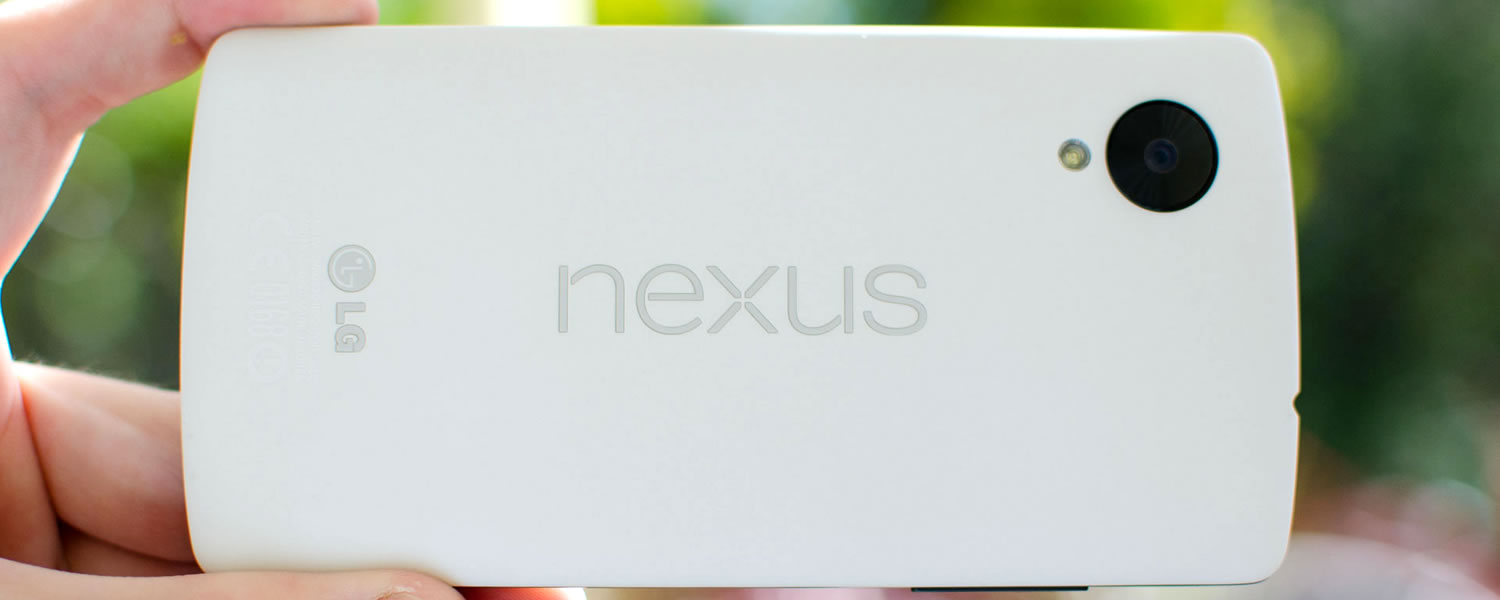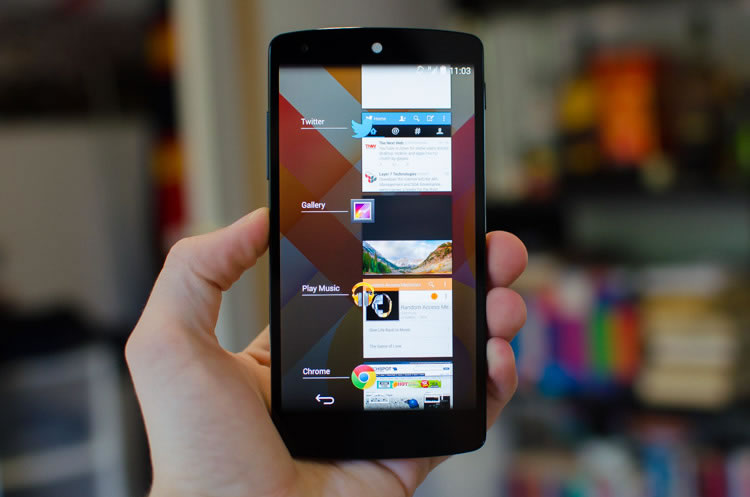Performance: It's Seriously Fast
My two last reviews on TechSpot have both been of Snapdragon 800-powered devices (the Sony Xperia Z1 and LG G2), so this section will likely be very familiar for those of you who have read either of them. The Nexus 5 features this Qualcomm-made top-of-the-line system-on-a-chip (SoC), which includes a 2.3 GHz quad-core Krait 400 CPU, 450 MHz Adreno 330 GPU, Hexagon QDSP6V5A DSP at 600 Mhz, an LTE modem block, Wi-Fi 802.11a/b/g/n/ac radios, Bluetooth 4.0 and GPS+GLONASS.
Complementing this monster SoC is 2 GB of LPDDR3-1600 RAM on a dual-channel 800 MHz bus, which is standard for Snapdragon 800 devices and provides 12.8 GB/s of bandwidth. Thanks to the guys at iFixit we also know the Nexus 5 has 16 GB (or 32 GB) of Sandisk-made NAND, a Broadcom BCM20793M NFC controller, a six-axis IvenSense sensor that provides the gyroscope and accelerometer, and a tri-axis compass.
When I was using the Xperia Z1, I thought that phone was extremely fast, but things stepped up a notch when I got my hands on the Nexus 5. Like other Snapdragon 800 devices, the user interface is quick to use and all animations are fluid, and the 2 GB of RAM allows a large number of applications to run in the background, ready to spring into action at a moment's notice. The main difference in speed, however, comes in loading apps, which is likely a product of under-the-hood optimizations in Android 4.4.
Regardless of whether an app has been loaded before or it's the first time, the Nexus 5 seems to open applications and load data just a fraction of a second quicker than other high-end devices. I'm sure the lack of heavy skinning also has something to do with the slight speed improvements, but it's great to see that Google continues to enhance and optimize the Android back-end. It'll be especially interesting to see how the optimizations affect slower devices like the Moto G, but that's for another review.
Browsing performance using Chrome is as solid as usual, so regardless of how content heavy a page is, it takes relatively little effort to switch between tabs and zoom around. Other regular tasks such as turning the phone on and off is instant, as is using the keyboard and browsing through contacts. Gone are the days of laggy Android and the Nexus 5 is a perfect example.
The Nexus 5 is also a capable gaming device, thanks to the power available to games from the Adreno 330 GPU. I tried a range of 3D heavy games on the Nexus 5, such as Dead Trigger 2, Real Racing 3 and a number of the latest Gameloft titles, and every single one worked fluidly, pushing near 60 frames per second (if not 60 frames per second) rendering at 1080p. Of course we're not talking console-like visuals here, but the phone nevertheless provides more than enough processing power for today's Android games.
Unfortunately, for gamers holding the device primarily in landscape, your fingers will readily cover up the speaker along the bottom edge, which is one of the downsides of not having the main speaker on the front or back. On to the device benchmarks, and I'm not expecting to see results that are significantly different from any of the other Snapdragon 800 handsets I've used over the past few months. There may be some slight differences due to Android 4.4 and the lack of any benchmark optimization code in the Nexus 5, but other than that it should be largely the same.


In Peacekeeper, which is run in the stock browser on the device (in this case Chrome), the Nexus 5 scored right in the middle of a band of Snapdragon 800-powered handsets, which indicates little to no speed improvements on this hardware in Android 4.4. In Vellamo's Metal benchmark, which tests the hardware capabilities of the device, the Nexus 5 again scored as we expected. Unfortunately the HTML5 test, which I also usually run, wasn't running correctly on the Nexus 5 (likely a product of code changes in Android 4.4), so it hasn't been included in this review.

The results from the Ice Storm Unlimited benchmark indicate there might have been some GPU performance optimizations made in Android 4.4 or in the device's firmware, as the Nexus 5 was 12% faster than the next-best Snapdragon 800-powered device.


While the Nexus 5 performed faster than the average Snapdragon 800 SoC in 3D Mark, when it comes to GFXBench the device scored on-par with similar handsets.

As you would expect, the Nexus 5 with USB 2.0 connectivity effectively hits the transfer limits in both directions. It would have been nice had USB 3.0 been implemented but I guess we can't have everything.
Without a microSD card slot, the maximum amount of storage you can achieve with a Nexus 5 is 32 GB. The model I received for review was a 16 GB model with 12.55 GB of usable space, which isn't a huge amount as I quickly managed to fill it up with 3 GB of apps and games, plus a portion of my music library and a few photos and videos. I'd highly recommend spending the extra cash to get the 32 GB model if you plan on using the device as your personal media player.
As for media playback itself, like other Snapdragon 800 devices the Nexus 5 has the power - thanks in part to the Hexagon DSP - to decode 4K video. This isn't a particularly useful capability right now, but in the coming years with the cheapening of Ultra HDTVs it will be handy to have mobile devices that can decode this sort of content. The stock Gallery application found in Android 4.4 isn't an amazing app by any means, so for video playback I'd highly recommend using a third-party alternative such as MX Player, which can still make use of the device's native decoding functionality.
Music quality through the 3.5mm headphone jack is acceptable by default, sounding somewhat less rounded than other handsets I've used recently and a little hollow in the vocal range. However, heading into Play Music's equalizer and setting it to 'Normal' with a small amount of bass boosting improves the audio quality, and of course there are many other setting to fine tune the output to your tastes.
The speaker located on the bottom panel is more rubbish than usual and should only be used occasionally where necessary. You're certainly not getting HTC BoomSound, so it'd be wise to carry around some headphones if you plan on gaming or watching a movie, not only to stop those around you from getting annoyed, but also so you get better sound quality.
During my field testing of the Nexus 5's wireless radios I encountered essentially zero performance issues to speak of. While I currently don't have an 802.11ac router to test with, performance on both the 2.4 GHz and 5 GHz Wi-Fi n bands was good, and HSPA+ speeds in my area were as good as any other device. A-GPS was fast to lock on, even indoors, and I ran into no troubles with Bluetooth 4.0 or NFC.
Interestingly I the new Broadcom NFC controller packs support for both SIM and non-SIM secure elements, which facilitates one of KitKat's new features: host-based card emulation. This essentially allows any application access to tap-and-pay features, among other things, and gets around carrier restrictions on Google Wallet. While some documentation seems to indicate this feature will work on any Android 4.4-powered device, it may require new NFC chips like the Broadcom one found in the Nexus 5, so I'll have to wait until other devices turn up running KitKat to see which one is correct.
Also, don't forget that there are two Nexus 5 models, one destined for North America (the D820 and the model I used for this review) and one for the rest of the world (the D821). Both phones have the same GSM bands and support mostly the same (and all the critical) HSPA+ bands, however LTE support is vastly different with each geared up understandably for the region it's designed for. If you want to check which model is suitable for your region, check Google's Nexus 5 specifications page.
Performance is once again an area of the Nexus 5 that is punching well above its price tag suggests. The Snapdragon 800 SoC remains at the top of the Android speed tree, providing fantastic CPU and GPU performance alongside modern specs such as Wi-Fi 802.11ac and LTE.




